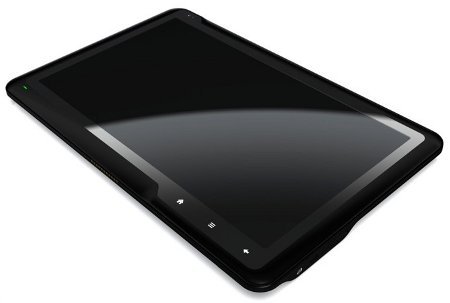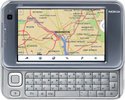ICD, HP tablets take shape as Nokia tablet rumors re-emerge
Apr 7, 2010 — by Eric Brown — from the LinuxDevices Archive — 1 viewsInnovative Converged Devices (ICD) is prepping an 11.2-inch, Android-based “Gemini” tablet that blows away the iPad on specs, says Engadget. Meanwhile, HP has tipped more details on its Slate tablet, which may run Android, and Nokia is rumored to be readying a tablet that runs the Linux-based MeeGo.
With the iPad shipping 300,000 units on its Saturday debut alone, other new tablets continue to pop up in leaks and rumors. Despite the fact that Apple appears to have another hit on its hands with the iPad, other vendors seem to be hoping the device will help pave the way for their own products rather than smother them. (Meanwhile, stories of early troubles with WiFi connections has rivals hoping that Apple may suffer a Nexus One style roll-out full of glitches and other mishaps.)
The latest tablet to emerge in the rumor-sphere is an 11.2-inch, Android-based "Gemini" model from ICD Innovative Converged Devices (ICD), according to a story this week in Engadget, which posted the photo below. At CES in January, ICD showed off two tablet designs, both based on Android. The new Gemini would fall in between the previously announced 15.6-inch Vega and 7-inch Ultra tablets.

ICD's Gemini
(Source: Engadget)
Like the other ICD tablets, the Gemini is built around a 1GHz Tegra 250 system-on-chip (SOC), according to Engadget. Unlike the iPad's A4 SoC, the Tegra 250 (or "Tegra 2") is claimed to support full HD video. Like the iPad, the Gemini offers a 3G connection, but unlike Apple's device, it also offers cellular telephony, says the story.
Other areas where the Gemini appears to beat out the iPad is the presence of a micro-USB port, GPS, an SD card reader, FM radio, and a user-replaceable 40 Watt hours battery (almost twice the duration of the iPad), says Engadget. The tablet is also said to best the iPad by offering dual cameras: a two-megapixel front-facing webcam and a five-megapixel autofocus still camera. Perhaps most importantly, it supports the Steve Jobs-maligned Adobe Flash, says the site.
Addit ional Gemini features are said to include 802.11n WiFi, Bluetooth 2.1, stereo speakers, accelerometers, and multi-touch, 1,366 x 768 resolution displays available in both resistive and capacitive flavors. Judging from the comparison table, the Gemini comes up a short on standard memory, supplying only 512MB of DDR RAM, and 4GB of flash, expandable to 32GB, but otherwise it appears to beat both the iPad and JooJoo (pictured at left) on the vast majority of specs.
ional Gemini features are said to include 802.11n WiFi, Bluetooth 2.1, stereo speakers, accelerometers, and multi-touch, 1,366 x 768 resolution displays available in both resistive and capacitive flavors. Judging from the comparison table, the Gemini comes up a short on standard memory, supplying only 512MB of DDR RAM, and 4GB of flash, expandable to 32GB, but otherwise it appears to beat both the iPad and JooJoo (pictured at left) on the vast majority of specs.
The story offered no hint as to when the Gemini might see the light of day, nor did ICD have any publicly available information on the device. Earlier this year, the company said that its 7-inch Ultra tablet should be available in the first half of the year, with the Vega due later in the year. The Ultra and Vega appear to share most of the Gemini's features except for the screen size, the 802.11n flavor of WiFi, the long-life, replaceable battery, the dual cameras, and cellular telephony. Some of these features, however, may be upgraded by the time the tablets ship.
HP tips more details on Slate
 On Monday, HP posted a video highlighting details of its HP Slate tablet, including features such as dual cameras, a USB port, and an SD card reader, according to a story in our sister site, WindowsForDevices. Although the Slate runs Windows 7, we are covering the news here for two reasons: First, due to HP's marketing and channel clout, the device (pictured at right) is likely to be one of the main challengers to the iPad; second, in January, both TechCrunch and The New York Times ran stories suggesting that an Android version of the Slate is also being prepared, with the latter story also stating that a Linux version may be in the works as well.
On Monday, HP posted a video highlighting details of its HP Slate tablet, including features such as dual cameras, a USB port, and an SD card reader, according to a story in our sister site, WindowsForDevices. Although the Slate runs Windows 7, we are covering the news here for two reasons: First, due to HP's marketing and channel clout, the device (pictured at right) is likely to be one of the main challengers to the iPad; second, in January, both TechCrunch and The New York Times ran stories suggesting that an Android version of the Slate is also being prepared, with the latter story also stating that a Linux version may be in the works as well.
The Slate will have an 8.9-inch screen with 1024 x 600 pixel resolution, 1GB of non-expandable RAM, and the capability of providing 1080p HD video playback, according to the HP video. The screen is said to be operable with a pen as well as with fingers. Both a VGA webcam, and a 3-megapixel camera are supplied, along with a USB 2.0 port and an SD slot that accepts up to 128GB of storage, says HP.
Meanwhile, the WindowsForDevices story also cites an Engadget story that says the Slate will run Windows Home 7 Premium on a 1.6GHz Atom Z530 CPU and SCH US15W northbridge/southbridge. According to the story, the Slate will offer only five hours of battery life instead of the iPad's 10, and like the iPad, will lack a user-replaceable battery.
Other cited features include 1GB of DDR2 RAM, 802.11b/g, Bluetooth, optional 3G, GPS, and audio I/O. The story also says the tablet will cost $550 or $600.
Nokia's tablet tipped again
According to TheStreet, which has not always been a bastion of reliability, Nokia is working with suppliers and design manufacturers on a touchscreen tablet that could be available as early as this fall. The tip came from Rodman Renshaw analyst Ashok Kumar, who is close to Nokia's technology partners, according to the publication. The story also suggests the tablet will run the Linux-based MeeGo operating system.
The story cites Kumar as suggesting that Nokia faces long odds of "finishing in the money in tablets." Hurdles not only include the iPad, but potential upcoming Chrome OS-based tablets, says the story.
TheStreet quotes a second analyst as saying that if such a tablet were to succeed, it might need the help of its MeeGo partner, Intel. That would also suggest that Nokia is considering an Intel processor, most likely the upcoming Moorestown.

Rumors of a successor to Nokia's Internet Tablet N810 (pictured at left) have been emerging since a year ago when TheStreet tipped a "Nautilus" device with "a very slim touchscreen design," that was supposed to have shipped by year-end 2009. The story at the time noted that a sensor on the Nautilus was used to extend or withdraw a QWERTY keyboard.
Since then, Nokia has shipped its N900, which in a sense is an update to the N810, but is smaller and much more clearly a smartphone than a tablet. The company said in November that it was working on another Maemo-based phone, and since then announced, with Intel, the MeeGo merger of the Linux-based Maemo and Moblin platforms. Last week, the MeeGo project announced that the N900 would be one of the first MeeGo reference platforms.
Availability
ICD may eventually offer information on its Gemini tablet at its website, here. The Engadget story on the tablet may be found here.
The WindowsForDevices story on the HP Slate may be found here.
The story on Nokia's tablet plans on TheStreet should be here.
This article was originally published on LinuxDevices.com and has been donated to the open source community by QuinStreet Inc. Please visit LinuxToday.com for up-to-date news and articles about Linux and open source.